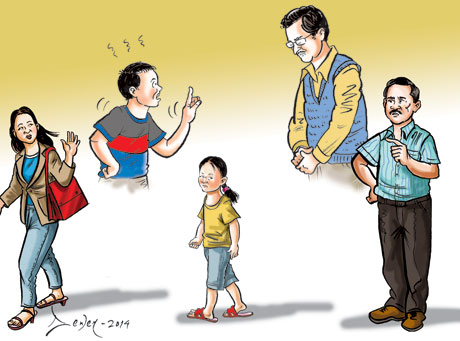
One of the most common activities that we do on a daily basis, and do it in increasingly more ways for more purposes, is writing. But writing for us is also like water for fish. “What water?” one fish might ask another fish that starts talking about water, unless the latter has been thinking about or deliberately observing water surrounding it. Likewise, most of us don’t pause to think and talk about writing. It is just what people do, and they have habituated, often fossilized, thoughts about it or have nothing to say. That means it’s important for us as educators to think about how we are going to meet the increasing academic, professional, and social demands of writing in Nepal.
In this post, I’d like to share some thoughts and experiences, and a particular vision, about how Nepalese academe could adopt and advance writing as a discipline and pedagogy, as a profession and vocation within the academic context. I am not thinking about creative writing, the writing done by the special “writers” within the humanities, or the writing done by a few “scholars” in other disciplines. Nor am I thinking about writing done by journalists or other kinds of professionals who write for a living. I am thinking about writing as a subject, like social studies or math in secondary school, and like compulsory English or particle physics in college. How can we advance writing as an independent subject that is taught by academic scholars or teachers who have studied it as a subject? How can we advance scholarly conversation and research about writing, in its academic and professional forms, for improving its social and economic applications? How can we develop writing as a field of study and practice, as a matter of curriculum and policy, as an issue of public awareness and demand? How can we help our schools and universities adopt systematic teaching, research, and training of teachers and other professionals around writing as a foundational part of secondary and higher education, as a vehicle for professional development? How can we write a writing education of our own?
We do currently have a writing education of sorts. It exists in many forms, many contexts, many manifestations. It is not a separate subject/curriculum taught to students across the board; there are only a course or two within disciplines like English Education. Writing should be a distinct subject, or at least a part of “writing, research, and communication” skills course. Instead of considering writing as one of four language skills and taught within English or Nepali language courses, we must add academic writing as a foundational course in high school and college. We must offer specialized and/or discipline-specific writing courses, such as professional writing to help college and university students prepare for different professions, scientific writing and technical writing to help students write well in STEM (Science, Technology, Engineering and Mathematics) and engineering, and writing courses for students who want to pursue academic careers in social science and humanistic fields. We also need academic and professional writing as a set of courses that form undergraduate writing major. And in order to produce writing teachers and scholars/researchers, we need writing degrees at the Master’s, MPhil, and Doctoral levels. We need departments of writing. We need conferences, journals and professional organizations for writing teachers and scholars.
One key question is what discipline is going to adopt writing, whether a new group of scholars are going to emerge and advance writing as an independent discipline, what shape our version of the discipline and profession of academic writing is going to take? Indeed, how do we characterize the courses/curricula and professional expertise in writing that we already have? Are the writing teachers, most of whom do not have specialized degrees or extensive training in the teaching and research of writing, going to lead this charge? Should they be connected to the broader community of writing scholars in the outside world? Are they and their new discipline and professional community–if such things are emerging or emerge in the future–going to be housed within another discipline, such as English Studies, English Education, or Applied Linguistics? Should a discipline and pedagogy of academic writing be limited within the context of English or Nepali for that matter? If so, what do the disciplinarity and linguistic identity of those other disciplines mean to the advancement of writing as a (sub)discipline and to the development of scholars/teachers with a distinct professional identity?
While putting in writing the chain of thoughts above, I was also thinking that we are yet to develop a significant understanding about writing–whether in our conferences and journals, blogs and other professional discussions or through curriculum change and teaching practices. As I indicated at the beginning of this post, Nepalese academe seems generally vague about academic writing, perhaps because it is not interested in this subject and only pay attention to it when there is a crisis. Writing is like a machine that people only talk about when it breaks down. Teachers talk about students “poor writing” when students fail in exams i.e. if they don’t assume that the students would have written perfectly if they knew what to write but writing mediates and can make or mar both the process and product of learning and assessment. It can open or close doors to the profession and often social success. Writing is not only a means of assessment in our education system–in fact, too much so–but also plays increasingly important professional functions. It is a means of democratic deliberation and participation, playing increasingly important roles there as well in a young democracy. And writing goes beyond professional application and social/civic action to empowering the individual in an era of rapid technological advancement and globalization where we conduct more work and communication through writing. So, it is time to challenge and reject problematic beliefs about writing in their place, teach and advance better understanding about the roles that writing plays in practice in today’s society (as well as academe). For instance, if we look at the so-called “genius” students, it is often because they know how to express and organize well what they know, through writing. They have a better grasp of the connection between reading or research and writing. They read and write rhetorically consciously. But these facts are lost on teachers and institutions alike because of the prevalence of many myths about writing.
Writing, many assume, comes naturally to individuals with a creative bent of mind. In reality, scientists who publish the results of their systematic research aren’t creative writers; nor are economists, journalists, or historians who are prolific writers. Writing is also often seen as an unteachable skill, one that must naturally emerge from regular reading, sustained practice, or just waiting until one has to do different kinds of writing in the “real world.” Learning to write happens, that is; there’s no need to teach writing. These assumptions and myths about writing take us back to understanding the nature and function of writing that we do or need. They prompt us to study the writing that our students must do, identify their struggles and failures and strengths, develop curricular and pedagogical strategies of intervention, put pressure on curricular and educational policies to recognize and integrate and support the teaching and study of writing. We must develop curricular models that will fit our own national and local contexts and needs. But we must also advance advocacy and education about writing–and that is what I mean by “writing” a writing education.
There is a need for those of us who are interested in making Nepal’s writing education visible, in promoting it professionalizing it, to come together and share our experiences and visions. There is a need for us to develop selling points, to show the exigency, to demonstrate the benefits of a more systematic and advanced writing education in secondary and tertiary education. It may not be the same discipline that we see in North America or Europe, or even in the rest of South Asia. It has to be built upon the expertise and resources we currently have, the demands and needs we can identify through research and exchange of ideas and practices. It is high time that we bring together those who are interested in and invested in teaching and advancing writing otherwise into a professional network or organization. This can help us educate other stakeholders about the benefits of teaching/learning writing more substantively, more systematically, more purposefully. It can help us show its applications that already exist, the gaps and pitfalls of how the teaching/learning of writing is currently done. We are yet to demonstrate to academe and the professions alike the importance and needs of well-developed writing skills in our students and our professionals.
It is time for Nepal’s writing teachers and scholars, in whatever proportion they would assume this academic/professional identity, to study and write the history of writing education in Nepal. We must understand and communicate what we have done well and what we haven’t. Collective action and ongoing conversation about academic and other forms of writing can also help us develop the arguments, the curriculum, the pedagogy, the practice, and the advocacy that we need for engaging other stakeholders. Together we can understand the uptakes, identify and try to overcome the obstacles. It is high time.


